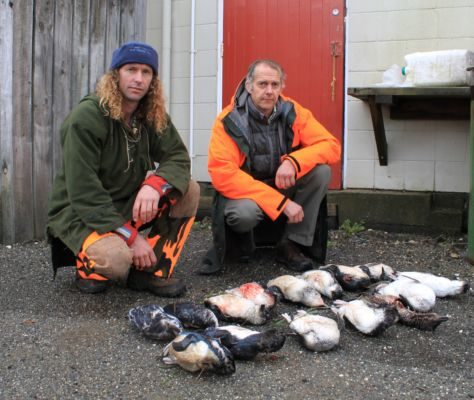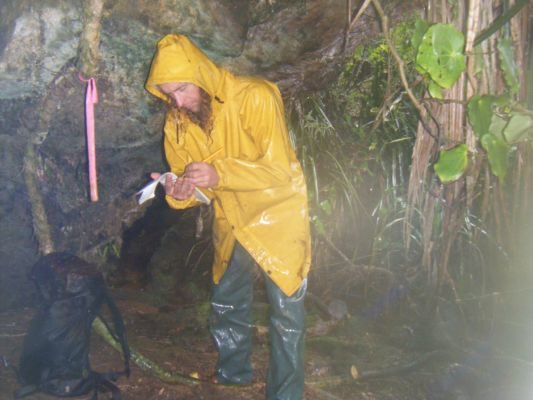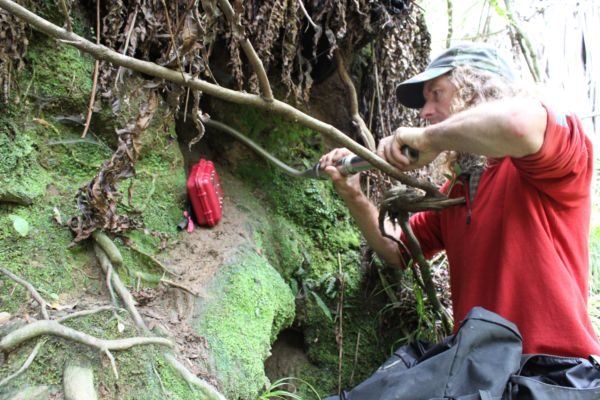Reuben Lane enjoys the staunch, feisty characters of the seabirds he’s helping to keep safe on the South Island’s West Coast – blue penguins, Fiordland crested penguins, petrels and fairy prions – they’re all birds with a bit of ‘attitude’. Based in Westport, Reuben moved to the Buller in 1998 to help Native Forest Action save ancient rimu from Government logging. He never left.

Nowadays he works as a ranger for the West Coast Penguin Trust. He joined the Trust early on to do stoat trapping.
“It was assumed that stoats were hammering the penguins. We did a lot of trapping,” says Reuben.

Over the last few years he has got to know the birds and the issues they face very well. For the last eight years he has monitored around 150 blue penguin burrows every week during their breeding season. Motion-activated cameras – trail cams – are also used to help monitor the colonies. For four years, two of the colonies in Charleston were trapped, and a third left untrapped for a ‘control’ comparison.
Cameras have shown stoats entering burrows in the non-trapped control colony. None were seen in the colonies where trapping was carried out and where predator numbers are now very low. But even though stoats are occasionally detected, Reuben has found that they are not quite the threat it was first assumed.
“Penguins in a burrow are quite ferocious. They’re staunch and can fight off a stoat unless it’s big, very hungry or the stoat has got a taste for penguin. They can’t stand up to a cat or dog.”
“In the four years I found one penguin killed by a stoat, eight by dogs and six by cars in the Charleston study” Reuben says. “Cats remove prey so they’re hard to detect,” he says, “whereas dogs normally just bite and kill them then run off to get another, leaving behind a dead penguin with characteristic injuries.”
“Once the Trust realised that road deaths were an issue on parts of the Coast road, they built a fence and that has worked really well.”
Dogs remain a problem. West Coast Penguin Trust newsletters frequently include a plea to dog owners to keep dogs leashed or ensure that they are under voice control if being exercised on the beach.

“There seems to be a pattern with blue penguins in Buller,” says Reuben. “The colonies are doing okay, holding their own. Most years the breeding is enough to replace themselves with slight growth. Then once in a while – maybe once in 10 years, a dog will go in and wipe them out. Just a couple of nights in a decade, but it means that the population declines.”
“People are in denial,” he says. “Stoats are not the main problem, humans are.”
The West Coast’s wet rainforest isn’t great habitat for stoats anyway. Stoats don’t get big on an invertebrate diet and, as Reuben says, some of the birdlife on the Coast can be pretty feisty.
The Fiordland crested penguins (tawaki) – the other penguins that Reuben monitors – also have an unusual breeding strategy which may allow for some losses to predation. Each breeding female lays 1½ eggs – that is, one normal sized egg and a smaller one which hatches into a smaller chick. It’s a sort of budget insurance policy where you don’t make a full-out effort with the ‘back-up’ chick, but it’s there if you need it or in a good year if there’s plenty of food to go around.
It’s a somewhat grim adaptation to the mantra of ‘survival of the fittest’ and breeding pairs rarely raise two chicks.
“It means that there’s always one dead chick in the nest each year,” says Reuben, “and, while stoats might scavenge that chick, it would probably have died anyway.”
The WCPT is in it’s 3rd year of a monitoring project to determine the significance of predation in tawaki colonies on the Coast and hopes to be able to publish results after this current breeding season. It is not known if the results will match the pattern found in blue penguin colonies in Charleston, or if stoats are actually a significant threat to tawaki breeding.

Reuben also carries out predator trapping at Cape Foulwind.
“There’s a little island offshore that’s full of fairy prions and smaller numbers of titi, – it’s the most significant seabird island between Open Bay Island and the Cook Strait. Stoat trapping is carried out to protect any muttonbirds still trying to nest on the mainland and to stop stoats swimming out to the island.”
Then there are the Westland black petrels.
“They’re fun, staunch birds,” says Reuben. “They’ve got full-on character. They’re awesome at night – a screaming cacophony of birds going crazy – like New Zealand hundreds of years ago! There’s no experience like being in a petrel colony,” he says. “It’s powerful!”

